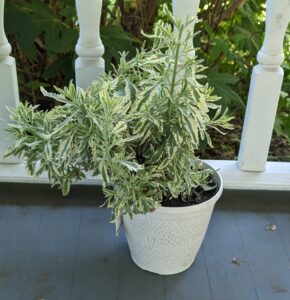 I love lavender or members of the rather large Lavendula genus, as do most sane gardeners. All the above-ground parts of the small, shrubby plants are fragrant—including leaves, stems and flowers. Of course the tiny blossoms, which are usually shades of purple or blue purple, but may also be pink or white, are the stars of the show. In addition to looking great in the garden and in dried arrangements, they lend their sweet clean scent to potpourri, sachets, culinary delights, and many other applications. Lavender is currently enjoying a special vogue with chefs, who include the dried flowers in everything from ice cream to salad dressing.
I love lavender or members of the rather large Lavendula genus, as do most sane gardeners. All the above-ground parts of the small, shrubby plants are fragrant—including leaves, stems and flowers. Of course the tiny blossoms, which are usually shades of purple or blue purple, but may also be pink or white, are the stars of the show. In addition to looking great in the garden and in dried arrangements, they lend their sweet clean scent to potpourri, sachets, culinary delights, and many other applications. Lavender is currently enjoying a special vogue with chefs, who include the dried flowers in everything from ice cream to salad dressing.
The challenge with lavender is that it likes specific climate and cultural conditions. Free draining soil is a must, as the plants are generally prone to root rot in water-retentive media like heavy clay soil. Drought is rarely a problem for established plants, but the hot sticky weather that tends to make human beings uncomfortable is equally discomfiting to lavender. The plants really want to be in places like the south of France, where some of the ancestors of today’s varieties evolved. I can’t blame them for that, but it means that I have to work harder to keep my lavenders happy and healthy.
Last weekend I bought a lovely new variegated lavender to fill a notable “hole” in the landscaping of my upper back garden. It is a large plant, with toothed leaves that are somewhat wider than the needle-like foliage on many lavenders. The leaf edges are cream-colored. While it is not in bloom yet, the fragrance of the leaves promises even sweeter scents to come when the flowers appear.
Like all plants, my new lavender has a Latin genus and species name, Lavendula x allardii, which is sometimes simplified to the English “Variegated Allard’s Lavender”. The “x” indicates that it is a hybrid of two distinct lavender species. The varietal name is ‘Meerlo’, which makes me think of both Merlot wine and meerkats. In point of fact, the variety is named for its introducer, Louis Meerlo of Classic Plants, located in Waiuku, New Zeeland. Mr. Meerlo discovered the new hybrid in one of his greenhouses in 2011. It was subsequently propagated and brought to the international market. As is often the case these days with new plants, the variety has also been patented in the United States.
‘Meerlo’ has distinguished parents. One of them is French or fringed lavender, known as Lavendula dentata, native to the Mediterranean and parts of northern Africa. “Dentata” refers to the toothed leaf edges, which the parent contributed to its allardii offspring. The relatively wide leaves on the new hybrid come from its other parent, spike or broadleaf lavender, also known as Lavendula latifolia. This Mediterranean native is noted for its especially pungent foliage, which features strong notes of camphor.
All of that adds up to a winning landscape plant, that grows two to three feet tall and produces slender spikes of pale purple flowers in early summer, along with its lavendula relations. Those flowers are also reputedly larger than those of some other lavenders. I will see if that reputation is borne out in a few weeks when blooms start to appear.
I love to interplant lavender with roses and catmint, an arrangement that provides decent ground cover and helps keep the deer away from the rosebuds. Like all members of the Lamiaceae or mint family, lavender is extremely attractive to pollinators.
It has also been attractive to humans for centuries. I grow enough of it in my garden to harvest bundles to dry, while leaving enough flower spikes for the bees and butterflies. Every drawer in my bedroom has its own lavender sachet, which I replenish with freshly dried blossoms every year. The slight fragrance is especially comforting when it wafts up from a woolly sweater on a cold winter day.
The ideal site for any lavender, including my Allard’s hybrid, is a slightly sloped, sunny situation with soil amended with sand or gravel. Sun is essential, but the slight slope is optional. The plants don’t need large quantities of water or fertilizer once established, but do benefit from being sheared back by about one third after the blooms have faded. This makes the plants bushier and encourages rebloom. I never throw away or compost the trimmings, but chop them up and distribute them around plants that are vulnerable to deer and other critters. It seems to help.
Allard’s is not the only variegated lavender. There are others, like the narrow-leafed Lavendula angustifolia ‘Platinum Blond’. They are worth a try if you want to add variety to an array of lavenders, or position as specimen plants. They can also be grown successfully in containers.
You can buy your own variegated Allard’s lavender from Annie’s Annuals, 801 Chesley Ave., Richmond, CA 94801; (888) 266-4370 Ext. 1; www.anniesannuals.com. Print catalog available.
